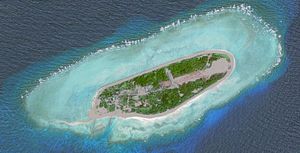During his keynote address Tuesday in Newport, international man of mystery Robert Kaplan recounted a tale that’s all too common in dealings between Americans and Chinese. A PLA senior colonel, reported Kaplan, opined that what China wants to accomplish in the South China Sea is “no different” than what the United States wanted to accomplish in the Caribbean Sea and Gulf of Mexico in the age of the Monroe Doctrine. Beijing wants to take charge of its nautical environs while cooperating with the preeminent sea power of the day elsewhere on the map.
See? To avoid hypocrisy, Washington should stand aside in China’s maritime quarrels with its neighbors.
Well, no. I don’t see. China’s methods resemble those America employed starting, say, after our Civil War (1861-1865). To a point. By the 1880s, the United States did embark on the construction of a great navy — a navy stronger than any European navy in the waters that mattered, namely the greater Caribbean. China has embarked on the construction of a great navy — a navy that, used in concert with shore-based weaponry, may surpass any Asian or outside navy in the waters that matter, namely the China seas.
So on Edward Luttwak’s technical and tactical levels of war, the good senior colonel has things more or less correct. Sea power: brilliant!
As the great Mark Twain wisecracked, though, the difference between the almost-right word and the right word is the difference between a lightning-bug and the lightning. The same goes for historical analogies. Chinese interlocutors are forever trying to use facile comparisons with U.S. history to get Americans to commit to unilateral intellectual disarmament. If we did it in the Caribbean then, how can we object when China does it in Southeast Asia now?
Clever. But let’s beware of taking history lessons from representatives of a regime that managed to airbrush such misdeeds as the Great Leap Forward, the Cultural Revolution, and Tiananmen Square out of official and popular memory while casting itself as the heir to the Confucian traditions it once sought to eradicate. These are folks set on convincing you the lightning-bug is the same thing as the lightning.
While China’s methods in nearby waters bear some resemblance to fin de siècle America’s, its goals could hardly be more different. The difference is between closed seas and skies ruled by a strong coastal state and freedom of the maritime commons. Both doctrines are about saltwater, but the resemblance stops there. Lightning-bug, lightning.
Or, if you prefer, the difference between the American and Chinese visions of maritime law is the difference between the 17th-century Dutch international-law theorist Hugo Grotius and his English foil, jurist John Selden. Grotius insisted the seas weren’t subject to national sovereignty — to ownership, in effect — while Selden proclaimed English sovereignty over the waters lapping against the British Isles. A century ago, as now, Grotius is the face of U.S. policy in the commons. Selden may as well be China’s prophet of maritime law.
Don’t believe me? Then consider: how did the United States comport itself during its rise to nautical eminence? To what uses did it put its burgeoning sea power? Well, for one thing, it never claimed ownership of the greater Caribbean, however much it coveted primacy there. There was no American counterpart to the nine-dashed line.
Nor, despite occasional glances toward Cuba and other islands, did Washington regard these jewels of the Caribbean as rightful U.S. property. Nor did any significant school of foreign-policy thought regard southern waters as a seaward extension of the North American landmass. Still less did official policy consider the sea sovereign territory or “blue national soil,” to borrow the ubiquitous Chinese phrase for the near seas.
Instead, the Monroe Doctrine was a unilateral directive forbidding European empires to reconquer American republics that had won their independence. The doctrine was popular in Latin America for decades. In 1906, for instance, the Brazilian government constructed Palácio Monroe in Rio de Janeiro. This majestic edifice honored James Monroe’s bequest on the occasion of the Third Pan-American Conference.
Can you imagine, say, the Philippines erecting Palácio Xi Jinping in Manila to celebrate China’s conduct in Southeast Asia? Me neither. Only in the 1910s did the Monroe Doctrine truly fall into disrepute in Latin America. That’s when U.S. leaders took to using it abusively, as a pretext for diplomatic and military interventionism rather than a common defense of the Americas.
Yet U.S. statesmen didn’t cling hardheadedly to even this most cherished of foreign-policy doctrines. In the 1920s, Washington retracted the Theodore Roosevelt “Corollary” to the doctrine, which Presidents William Howard Taft and Woodrow Wilson invoked as a license for intervention in Caribbean nations’ affairs. Presidents Herbert Hoover and Franklin Roosevelt subsequently ushered in the pan-American defense system that remains in place to this day.
In effect Hoover and FDR internationalized the Monroe Doctrine, enlisting fellow American states as co-guarantors of hemispheric security. Can you imagine Beijing walking back its nine-dashed line in similar fashion? One can hope — but don’t hold your breath.
So let’s not drink the Kool-Aid Beijing is peddling. When it disavows its claim to “indisputable sovereignty” over the South China Sea, reverses longstanding policy to favor freedom of the seas and skies, and, most importantly, wins buy-in from Asian neighbors, then I’ll be glad to welcome comparisons like the ones drawn by Kaplan’s senior colonel.
Until then … fuggedaboutit.

































